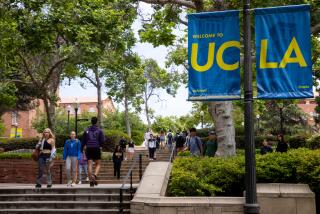Wanted: More Nurses
- Share via
We’re all getting older, and more of us are entering the vulnerable midlife and elder years than at any other time in history. These two facts are at the crux of a state and national emergency: a shortage of nurses.
Based on projections from the California Employment Development Department, the state will need 67,440 more registered nurses by 2006 than there were in 1996.
Factors contributing to an increased demand for nurses include population growth--about 1% a year nationally but averaging 1.5% in Orange County during the last five years. As this population ages and people live longer, they experience more chronic illnesses and acute conditions that require more care.
Like the rest of us, a large cohort of professional nurses are approaching retirement, scaling back the number of work hours or concluding their careers. Nursing professionals’ average age is 44.
Faculty resources are another pressure point. In both community colleges and baccalaureate nursing programs, there is a shortage of qualified faculty. According to the American Assn. of Colleges of Nursing, nursing school associate professors and assistant professors average 52 and 49 years old.
Attracting students to the profession is another factor in the shortage issue. The profession faces extreme competition from a vast array of occupational choices unavailable to the students of yesteryear.
Within the state’s 71 community college nursing programs, there is no consistent way for qualified applicants who have been turned away because of space limitations to be admitted the next year. Nursing programs are time-intensive, typically requiring at least three years to complete, unlike other community college career tracks.
As dire a situation as these facts portend, there is a supply-side solution. The heroes in the midst of this crisis are the California community colleges.
Few are aware that the majority of the nurses in this state are educated and trained there. These graduates are eligible to become registered nurses once they pass the state’s licensing examination. Satisfaction ratings support the argument that there is no difference in the quality of education of registered nurses trained at community colleges and those graduating from a baccalaureate program.
Last year, the legislature commissioned a study titled “Educating California’s Future Nursing Work Force.”
In a final report, the state’s three higher-education systems recommended that the state develop a plan to recruit, prepare and retain nurses. This included allocating funds for nursing programs in community colleges and in the California State University and the University of California systems.
This year, Assemblyman Lou Correa (D-Anaheim) introduced legislation (AB338) that would create a demonstration project to address the nursing shortage in Orange County as a public-private partnership.
Santa Ana College, Saddleback College and Cal State Fullerton, all with programs accredited by the National League for Nursing, were designated the pilot program’s higher-education participants.
Together they would develop curriculum and support services to attract and retain nursing program students. The bill would appropriate $2 million over two years to be matched by participating Orange County hospitals, a challenge that these institutions already have accepted with a total of $1.4 million.
As one who has worked in the community college system for more than 20 years, I know the role our colleges play. However, it was not until a recent personal experience that I became fully aware of the scope of service community college-trained nurses provide.
In December, my mother-in-law died. She suffered several major illnesses in her lifetime, facing all of them stoically and with patience and determination. Finally, she lost her battle with pancreatic cancer.
There were two great teachers for our family during this ordeal: my mother-in-law herself and the hospice nurse who taught us how to care for her at home and to make her passing a loving, intimate and miraculous moment.
It was no small source of pride for me to know that the nurse who carried us through those difficult moments was trained at a community college.
Nurses represent the difference between despair and hope, between despondency and acceptance when facing the inevitable, like the imminent death of a loved one.
Despite society’s focus on technology, it is nurses who are our best assurance of top-quality care, our advocates and the ones who protect our interests in the health-care setting.
For the sake of our future, we must expend resources to assure that community college-trained nurses will be there when we need them.
More to Read
Sign up for Essential California
The most important California stories and recommendations in your inbox every morning.
You may occasionally receive promotional content from the Los Angeles Times.









